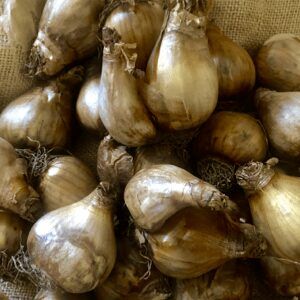Tips: How to Plant Flower Bulbs
Planting bulbs in Fall and Spring is one of my favorite things to do. A little investment and a ton of joy at bloom time. But over the years I’ve figured out it’s not as simple as just grabbing your sturdy bulb planter, making a hole, plopping in the bulb and done. My painful lessons learned, are now turned into 6 key tips for success when planting flower bulbs.
- Location is Everything – as with any plant, insuring the right amount of sunlight is key to growing beautiful flowers. For most bulbs, they will need at least 6 hours of sunlight to mature and produce flowers. Soil is key, and bulbs are heavy feeders and need fertile, well drained soil. Without drainage, the bulbs will rot over time and you will have nothing for your efforts. For early bloomers like Daffodils, you can plant the bulbs under trees as the blooms will happen before the leaves appear.
- Bed Preparation is Key – weed and loosen the planting area, and add a rich dose of compost to the soil as a preparation for planting your bulbs. Bulb depth is key, as bulbs that are plated too shallow or too deep will not grow. A good rule of thumb is 3 times the bulb size as a depth gauge. And make sure the pointy side is up!!!! A bulb planter with depth marks can really help.
- When to Buy Bulbs – it seems there is always a buying frenzy at the end of summer/beginning of fall to buy bulbs before they sell out. Buying bulbs early is fine, but proper storage until planting time is key. Bulbs need to be stored in a cool, well ventilated space to prevent rot, and keep them dormant until planting time. (see our lovely Dutch Flower Bulb selection).
- When to Plant Bulbs – timing on planting your bulbs is key, and all bulbs need time to “chill” before they go into growth mode. Timing varies across growing zones, but as a rule of thumb, once ground temperatures are 40-50 degrees F , you can go ahead and plant. For areas that dont have cool soil temps, you will need to place your bulbs in the fridge for 6 or so weeks to get results.
- Bulbs and Fertilizing – If you prepared the soil correctly as outline earlier, your bulbs will have all the nutrients they need to grow through fall and winter. You won’t have to fertilize until the first sign of green poking through your soil.
- Right Bulbs at the Right Time – remember, you can really classify all bulbs into Fall and Spring bulbs, and planting at the right time for the specific bulb is critical to success.
Good luck planting your bulbs!!!
Recent Posts
" "garden care" "gardening tips" "summer plants"summer gardening5 reasons why hardwood and stainless garden tools are best10 best DIY garden projects10 garden projects10 mosted asked garden questionsabout flower farmabout garden shopacidic soil hydrangeaall about garden pruner typesall about hydrangeasall about salviaall about succulents










